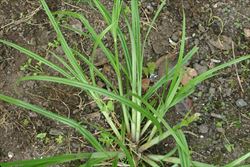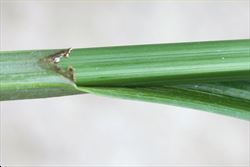Click on images to enlarge

habit (Photo: Trevor James)

stems and leaves (Photo: Trevor James)

close-up of stem, leaf sheath and base of leaf blade (Photo: Trevor James)

close-up of underside of leaf blade (Photo: Trevor James)

young seed-head (Photo: Trevor James)

branched seed-head subtended by several leafy bracts (Photo: Trevor James)

close-up of flower spikelets (Photo: Trevor James)

close-up of mature seed-head (Photo: Trevor James)
Scientific Name
Cyperus congestus Vahl
Synonyms
Mariscus congestus (Vahl) C.B. Clarke
Family
Cyperaceae
Common Names
clustered flatsedge, dense flat sedge, dense flat-sedge, dense flatsedge
Origin
Native to southern Africa (i.e. Lesotho, Namibia and South Africa).
Naturalised Distribution
This species is widely naturalised in the wetter regions of southern Australia (i.e. in eastern New South Wales, southern and eastern Victoria, Tasmania, south-eastern South Australia and south-western Western Australia).
It is possibly also naturalised in Brisbane in south-eastern Queensland, and is naturalised overseas in New Zealand and Hawaii.
Notes
This species, like many other sedges, is commonly a weed of roadsides, disturbed sites and damp ground. It also invades wetlands and waterways, and is regarded as an environmental weed in parts of Western Australia, Victoria, South Australia and New South Wales. It is regarded as an aquatic and wetland weed in Western Australia and listed as a moderately invasive species in WeedBase (i.e. a database of the environmental weeds of Western Australia).
Dense flat-sedge (Cyperus congestus) is also listed as an environmental weed in the wider Sydney and Blue Mountains region and in the Goulburn Broken Catchment in Victoria. In South Australia it has been recorded in the Onkaparinga River Recreation Park and is listed as a priority weed in the Pine Gully Reserve, near Adelaide.

